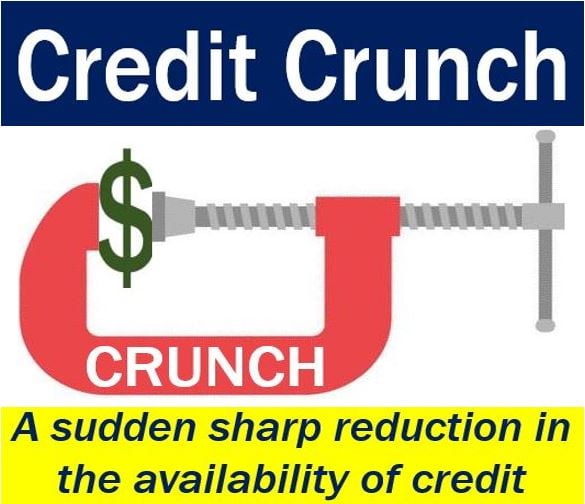A Credit Crunch, Credit Crisis, or Credit Squeeze occurs when the general availability of credit declines considerably. We also use the term when it suddenly becomes more difficult to get a bank loan.
The decline in the availability of credit occurs regardless of interest rates. In other words, the availability of credit falls whether interest rates rise or stay the same.
Banks and other creditors become reluctant to lend money during a credit crunch. Both individuals and companies notice the change.
Banks become reluctant to lend because of the greater risk of defaults. This is due to either political problems or adverse economic conditions.
Furthermore, the tightening of credit is often exacerbated by a decrease in consumer confidence, which leads to a reduction in spending and borrowing.
During a credit crunch, lenders become much more selective about who they lend to. Their focus shifts to quality rather than quantity.
When this occurs, lower-income and middle-class individuals lose out. Small-to-medium size companies also suffer. Ironically, during a credit crunch, those that continue finding it easy to borrow don’t need loans.

During a credit crunch, people and businesses that need help find it much harder to get loans. Banks focus on lending to those who least need to borrow.
Central banks attempt to counter this risk-aversion by reducing interest rates to stimulate money markets.
This reduction in the availability of credit may prolong an economic recession. It might also slow down a recovery. This occurred in the Great Depression.
During the Great Depression, the Federal Reserve reduced the money supply after the 1929 Wall Street Crash. It refused to liquefy markets, and thus triggered deflation. A depression is a severe economic downturn that continues for over three years.
A ‘credit squeeze’ is a milder version of a full-blown credit crunch. Many economists say that was what occurred in 2007/2008. However, as you can see in the quote below, the US Federal Reserve saw it as a credit crunch.
According to a Federal Reserve Bank of St. Louis review:
“The 2007-08 credit crunch has been far more complex than earlier crunches because financial innovation has allowed new ways of packaging and reselling assets.”
“It is intertwined with the growth of the subprime mortgage market in the United States – which offered nonstandard mortgages to individuals with nonstandard income or credit profiles – but it is really a crisis that occurred because of the mispricing of the risk of these products.”
Credit crunch frequency
Since the middle of the last century, credit crunches have struck more frequently.
Economists say it is impossible to predict when a severe lending contraction will occur. However, in every case, there is a clear correlation with house-price boom-bust cycles.
Professor Richard Rumelt, from UCLA Anderson School of Management, wrote in ‘Good Strategy – Bad Strategy’:
“In fact, during the past fifty years, there have been 28 severe house-price boom-bust cycles and 28 credit crunches.”
Prof. Rumelt was referring to the twenty-one advanced economies of the OECD. OECD stands for the Organization for Economic Co-operation and Development.
Financial analysts observe that technological advancements in banking and increased global interconnectivity can amplify the effects of a credit crunch by affecting a broader spectrum of the financial market.
Video – What is a Credit Crunch?
This video, from our sister channel on YouTube – Marketing Business Network, explains what a ‘Credit Crunch’ is using simple and easy-to-understand language and examples.
